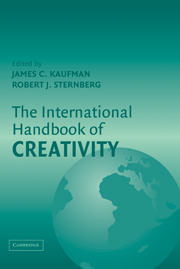Book contents
- Frontmatter
- Contents
- Acknowledgments
- List of Contributors
- 1 Introduction
- 2 Creativity Research in English-Speaking Countries
- 3 Creativity in Latin America
- 4 History of Creativity in Spain
- 5 Past, Present, and Future Perspectives on Creativity in France and French-Speaking Switzerland
- 6 Creativity in Italy
- 7 Creativity Research in German-Speaking Countries
- 8 Creativity Under the Northern Lights
- 9 Creativity in Soviet–Russian Psychology
- 10 Creativity Studies in Poland
- 11 Research on Creativity in Israel
- 12 Creativity in Turkey and Turkish-Speaking Countries
- 13 Development of Creativity Research in Chinese Societies
- 14 Creativity – A Sudden Rising Star in Korea
- 15 Culture and Facets of Creativity
- 16 African Perspectives on Creativity
- 17 Creativity Around the World in 80 Ways … but with One Destination
- Author Index
- Subject Index
- References
10 - Creativity Studies in Poland
Published online by Cambridge University Press: 05 June 2012
- Frontmatter
- Contents
- Acknowledgments
- List of Contributors
- 1 Introduction
- 2 Creativity Research in English-Speaking Countries
- 3 Creativity in Latin America
- 4 History of Creativity in Spain
- 5 Past, Present, and Future Perspectives on Creativity in France and French-Speaking Switzerland
- 6 Creativity in Italy
- 7 Creativity Research in German-Speaking Countries
- 8 Creativity Under the Northern Lights
- 9 Creativity in Soviet–Russian Psychology
- 10 Creativity Studies in Poland
- 11 Research on Creativity in Israel
- 12 Creativity in Turkey and Turkish-Speaking Countries
- 13 Development of Creativity Research in Chinese Societies
- 14 Creativity – A Sudden Rising Star in Korea
- 15 Culture and Facets of Creativity
- 16 African Perspectives on Creativity
- 17 Creativity Around the World in 80 Ways … but with One Destination
- Author Index
- Subject Index
- References
Summary
HISTORY
Creativity studies in Poland are deeply rooted in philosophical inquiries. One particularly influential work was authored by Władysław Tatarkiewicz (1976). In his brilliant analysis, the author detailed the historical and cultural development of creativity. Creativity was originally conceived as a divine activity, inaccessible for humans, who at most could aspire to skills, mastery, and craftsmanship. During the age of romanticism, creativity developed into the notion of inspired activity that cannot be understood or accounted for in terms of natural forces and mechanisms. Only in the twentieth century did creativity obtain its more naturalistic meaning as a human activity that results in a new, original work. Interestingly, Tatarkiewicz did not confine his criteria of creativity to sheer novelty, even if matched with other criteria, such as value or social impact. His definition of creativity clearly emphasizes the importance of human effort and energy used for the creation of pieces of art and other artifacts. Mental energy and effort employed in the process of creation appear to be as essential as novelty or originality of the output. In this way, Tatarkiewicz anticipated the modern psychological conceptions of “potential creativity” (Runco & Charles, 1997).
An important predecessor of modern creativity studies in psychology and education was Stefan Szuman (1927). He analyzed the phenomenon of play, particularly children's drawings, as a naturally creative activity.
- Type
- Chapter
- Information
- The International Handbook of Creativity , pp. 270 - 306Publisher: Cambridge University PressPrint publication year: 2006
References
- 11
- Cited by



